2. 中国科学院地理科学与资源研究所/生态网络观测与模拟重点实验室,北京 100101;
3. 贺州学院 食品与生物工程学院, 广西 542899
2. Institute of Geographic Sciences and Natural Resources Research, Chinese Academy of Sciences Modeling/Key Lab of Ecosystem Network Observation and Modeling, Beijing 100101, China;
3. College of Food and Bioengineering, Hezhou University, Hzchou, Guangxi 542899, China
全球气候变化是21世纪以来人类所面临的重要环境问题[1]。中国是目前世界上温室气体排放量最高的国家,根据《中华人民共和国气候变化第二次国家信息通报》[2],2005年其温室气体排放量已达到74.67亿吨CO2当量,其中CO2、CH4和N2O分别占80.03%、12.49%和5.27%。农田生态系统是重要的温室气体排放源,2005年中国农业源温室气体排放达到819.97百万吨CO2当量,占中国温室气体排放总量的11%[2]。旱作农田是产生农田土壤CO2和N2O排放的主要来源。华北平原是我国主要的粮食产区,冬小麦−夏玉米一年两熟制是该地区主要的种植模式。近年来该地区氮肥的施用量有的甚至高达N 600 kg/(hm2·a)[3],研究表明,这种施肥方式会造成环境污染[4–6],使得土壤排放大量的CO2[7–8]和N2O[9–10],因此,合理施肥尤为重要。合理施用有机肥可以维持作物产量[11]、提高土壤肥力[12]、增加土壤有机碳 (SOC) 的固存[13]、减少土壤全氮 (TN) 的损失[14–16]及减缓温室效应[17]。可见,优化农田管理措施对于维持或提高作物产量、固碳减排具有重要作用[18]。
模型是综合评价农田生态系统碳氮收支的有利工具。目前,国内外很多的土壤−作物模型用于估计作物品种性能、优化农田管理措施[19–21]及预测未来气候条件下作物产量及温室气体排放的变化[22–23]。如APSIM和SOILN-CROP模型广泛用于农田作物产量估算和土壤氮循环模拟[24–25]。DNDC模型广泛用于农田不同管理措施和气候条件下作物生长、土壤碳氮动态变化、温室气体排放及土壤水分平衡的模拟[26–27]。利用模型来模拟及评价不同施肥措施下的农田土壤温室气体排放已成为当今研究热点及全球趋势[28]。SPACSYS模型是一个多维的、田间尺度的、由气候驱动的机理过程模型[29],可以模拟土壤−植物−微生物之间的碳氮循环过程,具有详细的植物生长发育模块和根系模块,已广泛用于估计作物产量、SOC和全氮储量、土壤氮淋溶、作物的资源利用率和气候变化对作物生长的影响[30–33]。本研究利用长期试验历史数据,进行SPACSYS模型的参数化和验证,预测未来不同施肥 (减氮及增氮) 情景下作物产量、土壤碳氮储量及土壤温室气体排放的变化。
1 材料与方法 1.1 试验点位试验点位于河南封丘中国科学院封丘农业生态国家实验站 (35°00′N、114°24′E)。该地区属暖温带季风气候区,年均温13.9℃,年均降雨量615 mm,主要集中于7—9月份,无霜期220 d左右。长期施肥试验开始于1989年秋,采用冬小麦/夏玉米一年两熟种植制度。试验小区土壤为轻壤质黄潮土,试验开始前耕层土壤 (0—20 cm) 的理化性质为:有机质5.83 g/kg、全氮0.445 g/kg、全磷0.50 g/kg、全钾18.6 g/kg、pH 8.65。
1.2 试验设计具体田间管理措施,如施肥量及施肥方式见表1。冬小麦10月中旬播种,次年6月初收获,玉米播种于6月中旬,9月底收获。化肥和有机肥均匀施于土壤表面,通过耕作翻耕到0—20 cm土层。每年分别在6月和10月耕作2次,1月和7月灌溉两次。有机肥是小麦秸秆、大豆饼和棉籽以100∶45∶40的比例为原料,机械粉碎到3~5 mm后充分混匀并发酵2个月堆制而成。有机肥的化学性质如表2所示。
| 表1 化肥及有机肥年施用量 Table 1 Annual application rate of chemical fertilizer and manure to each crop under different treatments |
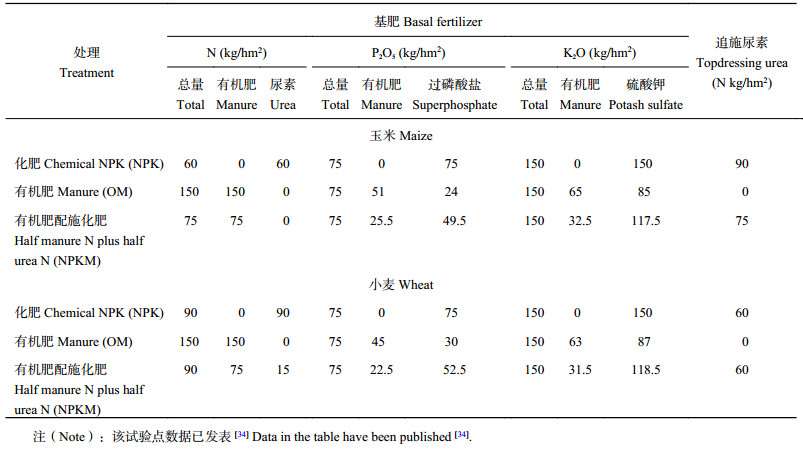 |
| 表2 小麦、玉米施用的有机肥质量及年施用量 Table 2 Quality and annual application rates of manures used in wheat and maize |
 |
本研究选取3个施肥处理来参数化和验证SPACSYS模型对长期不同施肥措施下作物产量、土壤肥力及土壤温室气体排放的模拟效果。3个施肥处理分别为:1) 氮磷钾化肥 (NPK);2) 1/2氮磷钾化肥 + 1/2有机肥 (NPKM);3) 有机肥 (OM)。其中NPK处理数据用于计算模型的参数,NPKM和OM处理数据用于验证模型参数的准确性。SPACSYS模型的主要参数设置如表3所示。在长期定位试验基础上,以NPK、NPKM和OM处理为当前施肥情景,在其基础上分别设置减氮25%和50%,增氮25%和50%四种情景,即:75%NPK、50%NPK、125%NPK、150%NPK、75%NPKM、50%NPKM、125%NPKM、150%NPKM、75%OM、50%OM、125%OM和150%OM,利用建立的SPACSYS模型,模拟1991—2050年作物产量、SOC和TN储量及土壤CO2和土壤N2O排放的动态变化,探讨至2050年不同施肥措施对农田土壤固碳减排的影响。
| 表3 SPACSYS模型有关作物生长发育及碳氮循环过程的参数 Table 3 Related parameters of crop growth and development, carbon and nitrogen cycles in SPACSYS model |
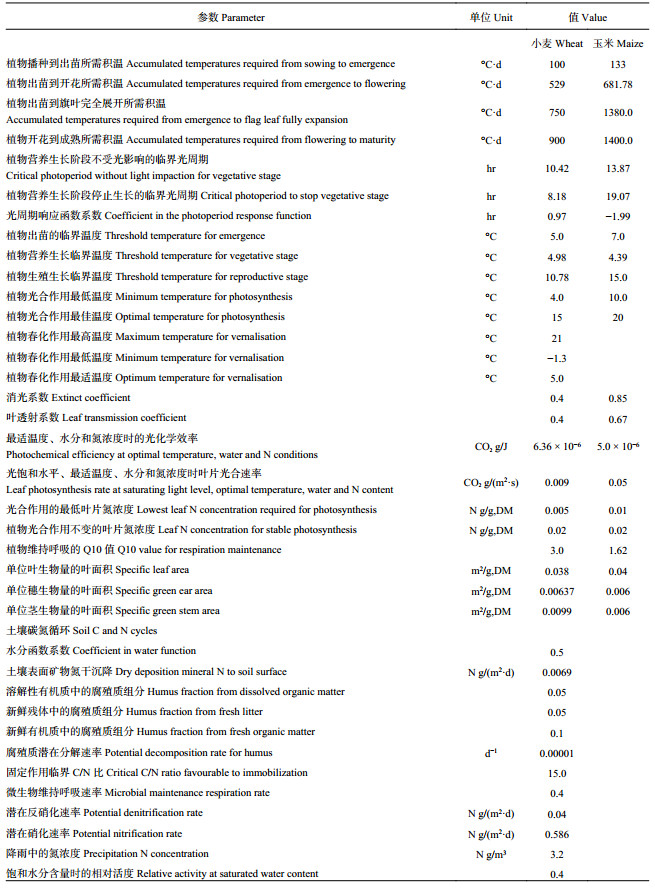 |
SPACSYS模型是一个多维的、田间尺度的、由气候驱动的机理过程模型。模型包括土壤−植物−微生物之间的碳氮循环模块、水分移动模块和热量传输模块,各模块间相互联系调用。模型不但可以模拟植物发育、光合、呼吸、光合产物的分配、根系生长及对养分和水分的吸收,而且具有可以准确模拟作物根系生长的3D根系模块。在土壤碳、氮循环模块中,有机质模块分为新鲜有机质库、可溶解有机质库、新鲜残体、微生物库和腐殖质库,无机氮 (铵态氮和硝态氮) 和可溶性有机氮等运移过程 (随水在土壤剖面移动、随水移动到田间排水管或深层地下水、径流损失等)。SPACSYS模型的输入数据主要包括气象数据 (日最高最低温度、降雨量、平均风速、日照时数和辐射等)、土壤性质数据 (有机质、pH和黏粒粉粒砂粒含量) 和田间管理数据 (包括种植、施肥、耕作、灌溉等)。有关模型的结构及相应模块的方程设置可参考相关文献[29,35–36]。针对华北平原冬小麦/夏玉米农田生态系统,本研究主要对植物开花到成熟所需积温、消光系数、植物叶片最大光合效率等作物参数及腐殖质潜在分解速率、溶解性有机质中的腐殖质组分、新鲜有机质中的腐殖质组分等土壤碳氮循环过程参数进行模拟和校正,表3为模型调参后的主要参数设置,有关模型参数的具体介绍可参考相关文献[29–31, 37–38]。调参后的模型能更好地模拟作物生长及土壤的碳氮循环过程。表4为模型调参后的模拟效果。
1.4 数据分析应用SPACSYS模型进行模拟,采用SPSS v.22.0进行数据分析,Microsoft Excel 2016和SigmaPlot 12.5进行图表绘制。计算模拟值和实测值之间的相关系数 (R2)、均方根误差 (RMSE) 和模型预测效率 (EF),以定量评估模拟值与实测值的吻合度。
2 结果与分析 2.1 作物产量、土壤碳、氮储量的模拟各处理产量的模拟值与实测值比较 (图1) 显示,SPACSYS模型模拟小麦和玉米产量的效果较好。由表4可知,用来参数化的小麦和玉米产量的相关系数分别为0.78(n = 5,P < 0.05) 和0.76( n = 5,P < 0.05),均方根误差分别为3.78%和3.81%。用来验证的小麦和玉米产量的相关系数分别为0.72( n = 10,P < 0.01) 和0.63( n = 10,P < 0.01),均方根误差分别为3.92%和4.86%。模型对小麦和玉米产量的模拟效率均趋近于1,说明SPACSYS模型可以模拟小麦和玉米的生长。
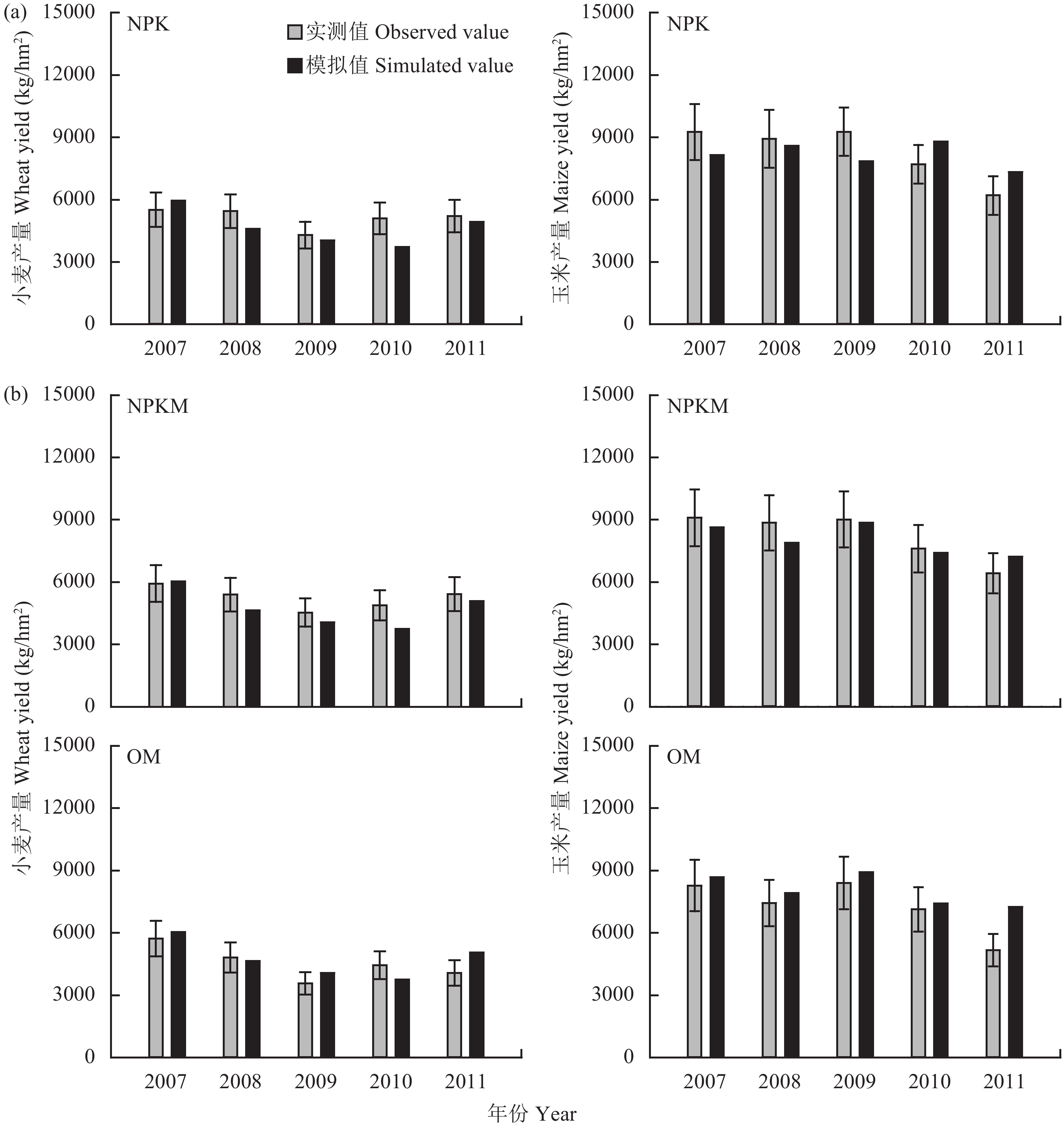 |
| 图1 封丘点位小麦产量和玉米产量的模拟值与实测值 Fig. 1 Simulated and observed grain yields of wheat and maize over the simulated period at the Fengqiu site [注(Note):(a) 模型参数化的模拟值和实测值之间的比较 Comparison of simulated values with observed values for calibration; (b) 模型验证的模拟值和实测值之间的比较 Comparison of simulated values with observed values for validation; 误差线代表标准误差 The error bars represent standard deviations; 实测数据来源于已发表文献[39] Observed values come from published literature[39].] |
SOC和全氮储量的模拟值与实测值比较见图2和表4。1989—2009年,模型模拟的NPK、NPKM和OM处理的0—20 cm土层SOC储量的模拟变化量依次为C 607.9、920.3和1341.1 g/m2,实测变化量依次为C 480.2、910.2和1375.6 g/m2,二者较一致。三个处理0—20 cm土层TN储量的模拟变化量依次为N 37.8、70.0和70.0 g/m2,实测变化量依次为N 30.2、81.1和122.3 g/m2,模拟值较实测值NPK处理升高了25%,NPKM和OM处理分别降低了14%和43%。模型验证的NPK处理SOC和TN储量的模拟值与实测值之间的相关系数分别为0.88(n = 22) 和0.76(n = 10),均达到极显著水平 (P < 0.01)。
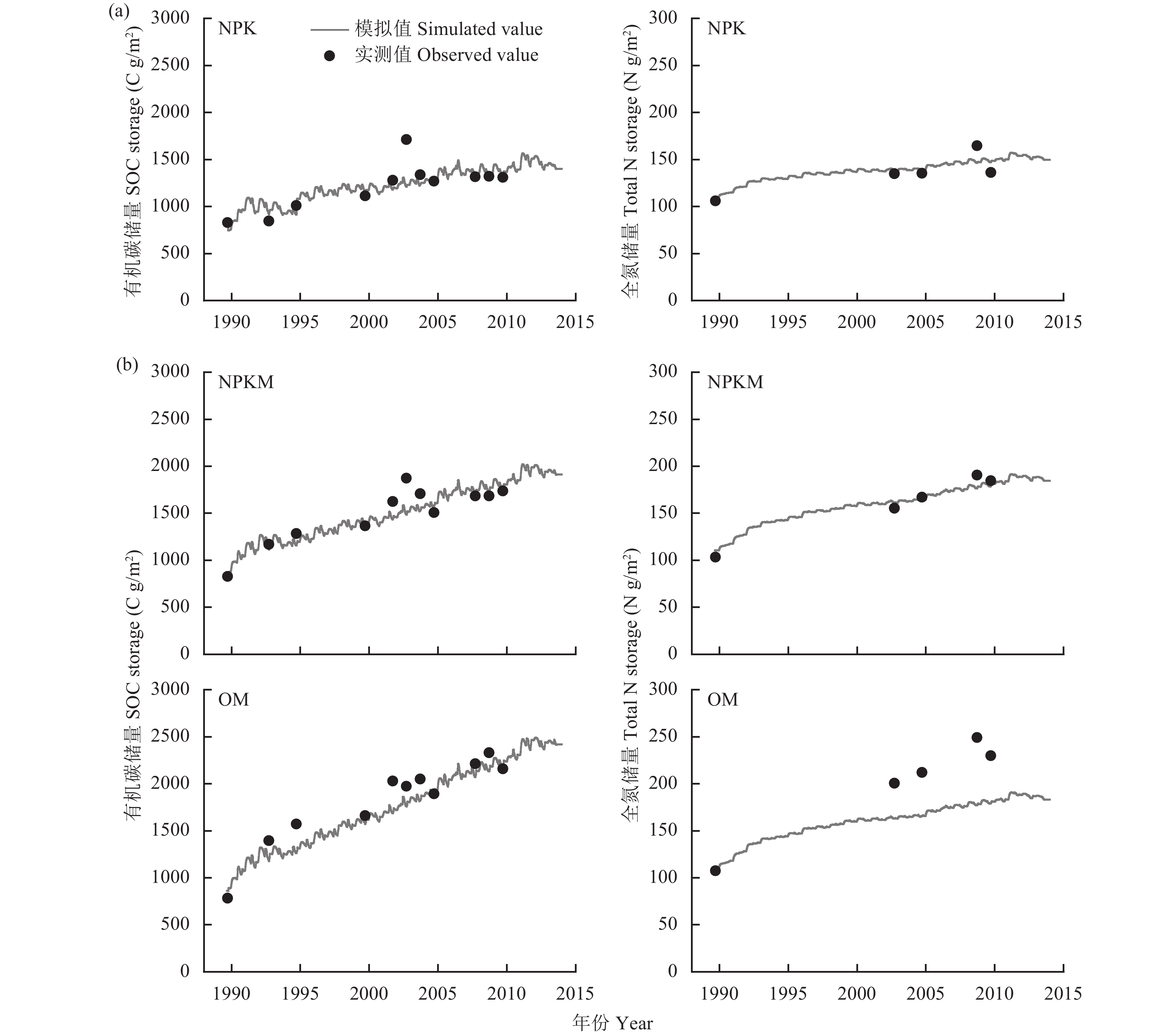 |
| 图2 封丘点位0—20 cm土层SOC储量和全氮储量的模拟值与实测值 Fig. 2 Simulated and observed SOC and TN storages in top 20 cm of soil over the simulated period at the Fengqiu site [注(Note):(a) 模型参数化的模拟值和实测值之间的比较 Comparison of simulated values with observed values for calibration; (b) 模型验证的模拟值和实测值之间的比较 Comparison of simulated values with observed values for validation; 实测数据来源于已发表文献[34,39–42] Observed values come from published literature[34,39–42].] |
准确模拟土壤CO2和N2O排放的基本条件是对土壤温度和土壤水分的准确模拟。结果显示 (图3、表4),模型通过了对土壤温度和土壤水分模拟的检验,土壤温度的模拟效果,R2为0.92~0.93(P < 0.01),RMSE为2.11%~2.32%;土壤水分的模拟效果,R2为0.12~0.23(P < 0.01),RMSE为8.87%~9.32%。
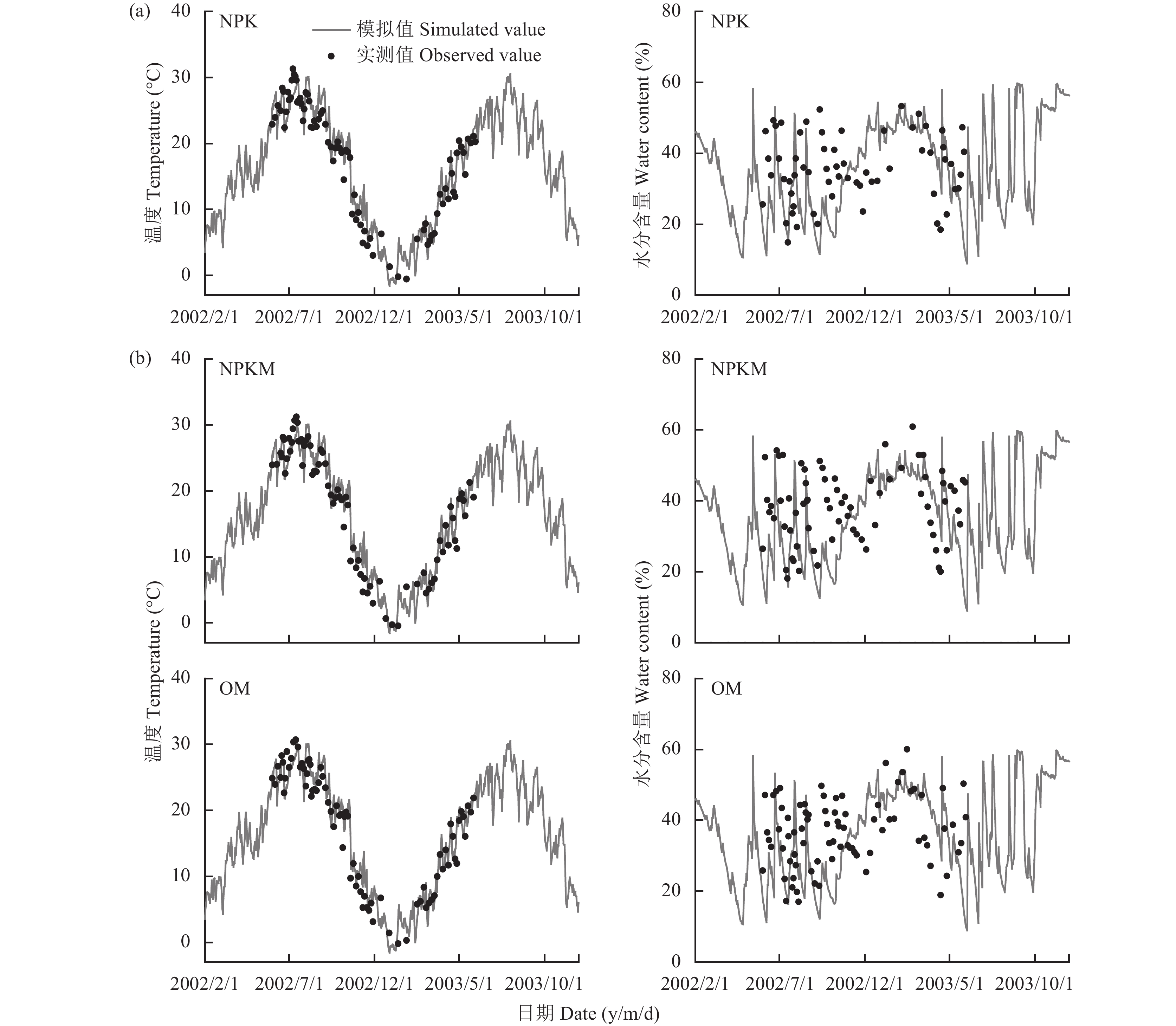 |
| 图3 封丘2002—2003年5 cm土层土壤温度和水分的模拟值和实测值 Fig. 3 Simulated and observed soil temperature and water content at the 5 cm depth at Fengqiu from 2002 to 2003 [注(Note):(a) 模型参数化的模拟值和实测值之间的比较Comparison of simulated values with observed values for calibration; (b) 模型验证的模拟值和实测值之间的比较Comparison of simulated values with observed values for validation; 实测数据来源于已发表文献[34] Observed values come from published literature[34].] |
土壤CO2和N2O排放量的模拟值和实测值如图4所示。模型可以很好地模拟出土壤CO2排放的动态变化。NPK、NPKM和OM三个施肥处理土壤CO2排放量的模拟值依次为C 0.25~3.57、0.27~3.80和0.22~3.15 g/(m2·d),实测值依次为C 0.04~4.13、0.06~4.12和0.06~3.48 g/(m2·d)。统计结果表明 (表4),用于模型参数化的NPK处理和用于验证的NPKM、OM处理的CO2模拟值与实测值之间的相关系数分别为0.80(n = 68,P < 0.01) 和0.72( n = 136,P < 0.01),RMSE分别为4.03%和4.11%,EF分别为0.78和0.77。
模型模拟了土壤N2O排放的季节变化模式,基本捕捉了农田施肥后的土壤N2O主要排放峰,并且模拟的排放峰的峰值及出现时间均与实际监测的较为接近 (图4)。用于模型参数化和验证的模拟值与实测值之间的相关系数分别为0.16(n = 66,P < 0.01) 和0.21( n = 132,P < 0.01),RMSE分别为9.99%和9.97%,EF分别为0.24和0.28 ( 表4)。
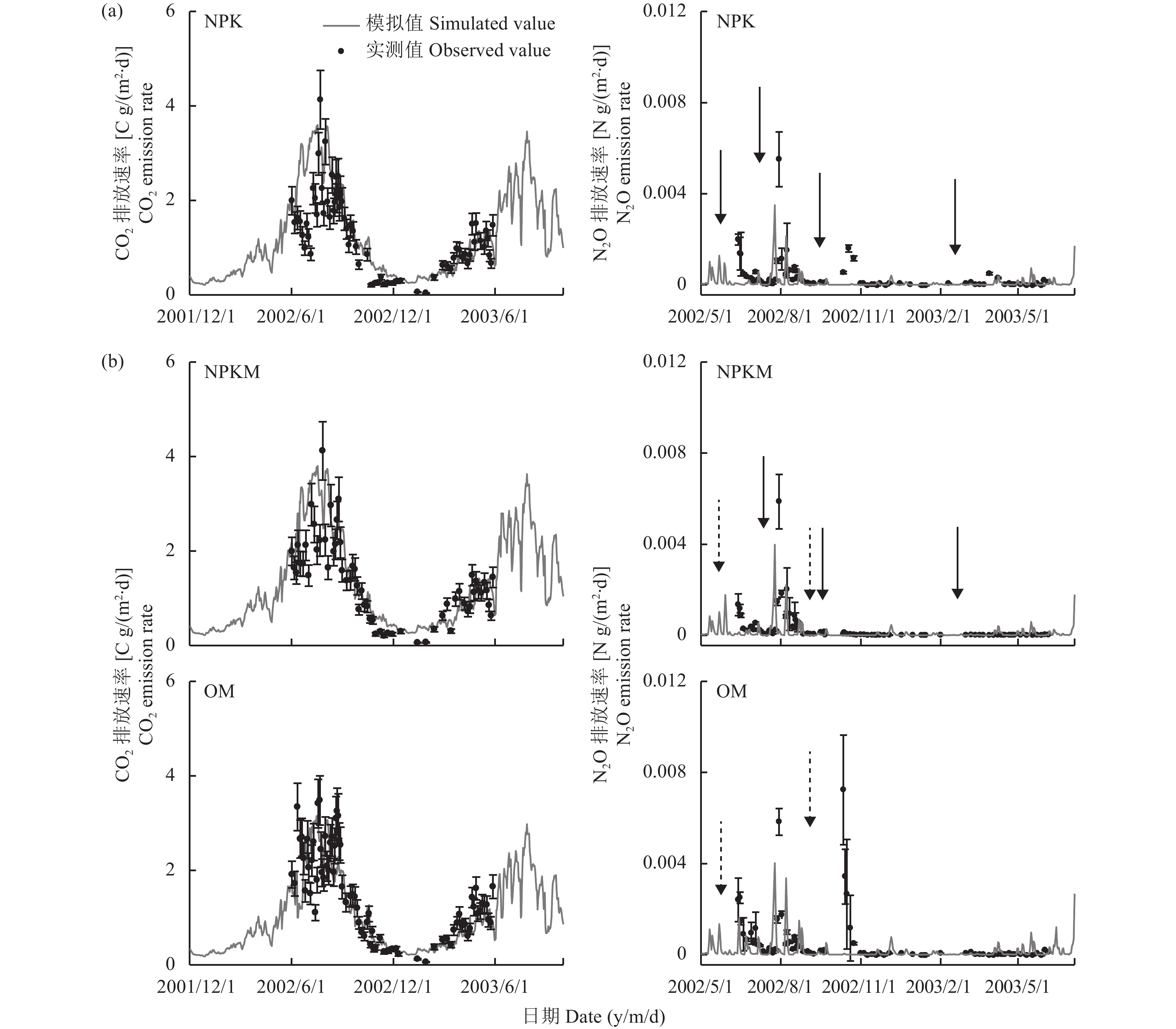 |
| 图4 封丘2002—2003年土壤CO2和N2O排放的模拟值和实测值 Fig. 4 Simulated and observed soil CO2and N2O flux from 2002 to 2003 at the Fengqiu site [注(Note):(a)模型参数化的模拟值和实测值之间的比较 Comparison of simulated values with observed values for calibration; (b)模型验证的模拟值和实测值之间的比较Comparison of simulated values with observed values for validation; (a) 和 (b) 中的实线箭头代表施用化肥,虚线箭头代表施用有机肥 Solid arrows in (a) and (b) represent the application events of mineral fertilizers, dot arrows represent application events of manure. 误差线代表标准误差 The error bars represent standard deviations of data points(n = 3); 实测数据来源于已发表文献[34,43] Observed values come from published literature [34, 43].] |
表5为SPACSYS模型模拟不同施肥情景60年 (1991—2050) 的作物年均产量、SOC和TN年均储量及土壤CO2和N2O的年均排放量。与当前施肥情景相比,减氮50%会显著降低玉米产量约9%,增氮25%或50%均不能显著提高小麦和玉米产量 (约提高5%~7%)。
| 表5 长期不同施肥情景下作物年均产量、土壤碳氮年均储量及土壤温室气体年均排放量 (1991—2050) Table 5 Average annual grain yield, average annual SOC and total N storages and average annual greenhouse gas emissions under different long-term fertilization scenarios during the experimental period (1991−2050) |
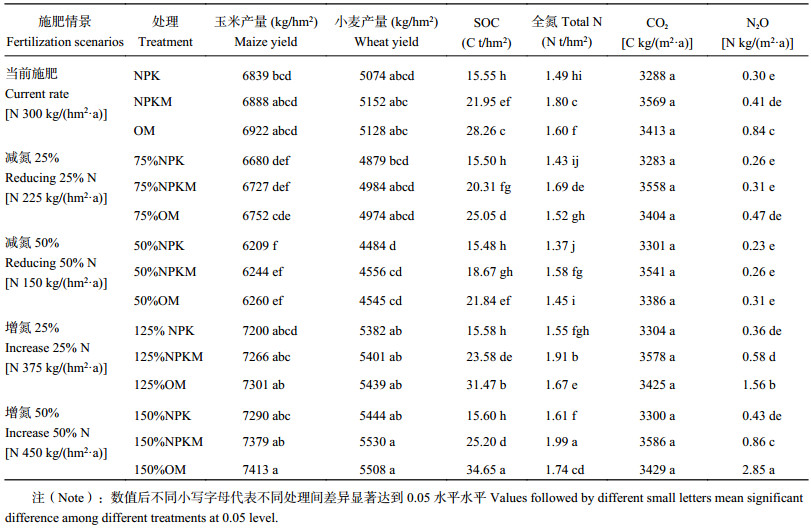 |
长期施肥60年 (1991—2050) 各处理SOC和全氮储量均表现为缓慢上升的趋势,150%OM处理SOC储量增量最大,由C 9.47 t/hm2升高到C 59.20 t/hm2,提升了525%;50%NPK处理增量最小,由C 9.18 t/hm2升高到C 21.08 t/hm2,提升了130%。全氮储量较SOC储量增加量小,其中150%NPKM处理增量最大,由N 1.13 t/hm2升高到N 2.39 t/hm2,提升了112%;50%NPK处理增量最小,由N 1.11 t/hm2升高到N 1.49 t/hm2,提升了34%(图5)。当前施肥情景及减氮25%施肥情景下,有机肥配施化肥处理的SOC和全氮年均储量显著高于单施化肥处理,如NPKM处理与NPK处理相比,SOC和全氮年均储量分别增加了C 6.4 t/hm2和N 0.31 t/hm2;75%NPKM处理与75%NPK处理相比,SOC和全氮年均储量分别增加了C 4.81 t/hm2和N 0.26 t/hm2(表5)。
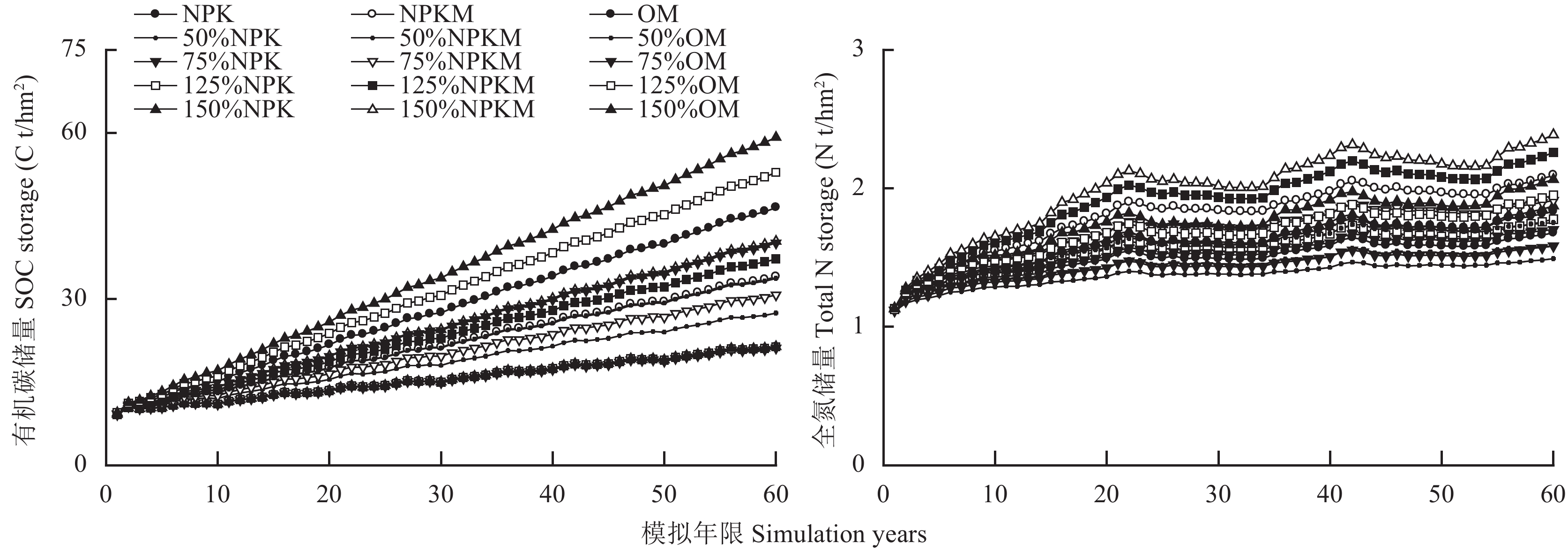 |
| 图5 长期不同施肥情景下0—20 cm土层SOC储量和全氮储量的动态变化 Fig. 5 SOC and TN storages in the top 20 cm of soil under different long-term fertilization scenarios |
长期不同施肥情景下农田土壤均表现为表观碳库,其中150%OM处理的土壤碳库最大,达到C 7885kg/(hm2·a)。与当前施肥情景相比,减氮施肥可以减弱土壤的“碳汇”效应,增氮施肥可以加强土壤的“碳汇”效应。同一施氮量水平下,土壤表观碳库的大小顺序为:单施有机肥 > 有机肥配施化肥 > 单施化肥 ( 表6)。长期不同施肥情景下农田土壤氮收支如表7所示,150%OM处理表现为表观“氮源”,125%NPKM、125%OM和150%NPKM处理表现为微弱的表观“氮汇”,150%NPK处理的土壤“氮汇”效应最大,达到N 115.4 kg/(hm2·a)。同一施氮量水平下,单施化肥处理的土壤“氮汇”效应大于有机肥配施化肥和单施有机肥处理。减氮施肥可以降低通过反硝化作用及淋溶径流途径的氮素损失。
| 表6 长期不同施肥情景下土壤−植物系统的年均碳收支预测[C kg/(hm2·a)] Table 6 Simulated average annual C inputs and outputs of the soil−plant system under different long-term fertilization scenarios from 1991 to 2050 |
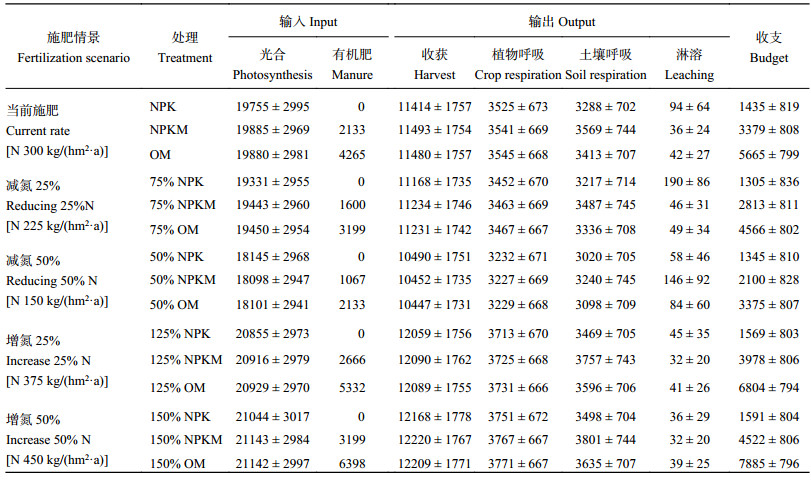 |
| 表7 长期不同施肥情景下土壤−植物系统的年均氮收支预测 [N kg/(hm2·a)] Table 7 Simulated average annual N inputs and outputs of the soil−plant system under different long-term fertilization scenarios from 1991 to 2050 |
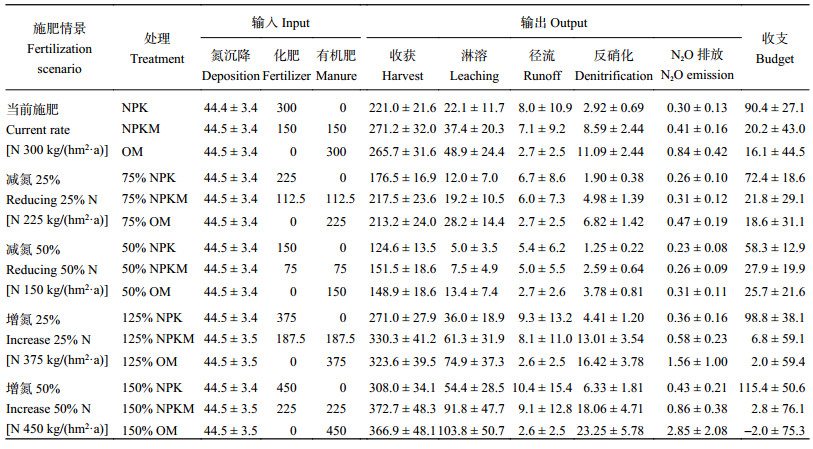 |
长期施肥60年 (1991—2050) 各处理土壤CO2的年均排放量在C 3288~3586 kg/hm2之间,均无显著差异 (表5),说明减氮施肥及有机肥配施化肥均不能显著降低土壤CO2年均排放量。长期施肥60年 (1991—2050) 各处理土壤N2O的年均排放量差异明显,其中150%OM处理最高,达到N 2.85 kg/hm2,50%NPK处理最低,为N 0.23 kg/hm2 (图6)。当前施肥情景下,单施有机肥处理减氮25%或减氮50%均能显著降低N2O年均排放量。
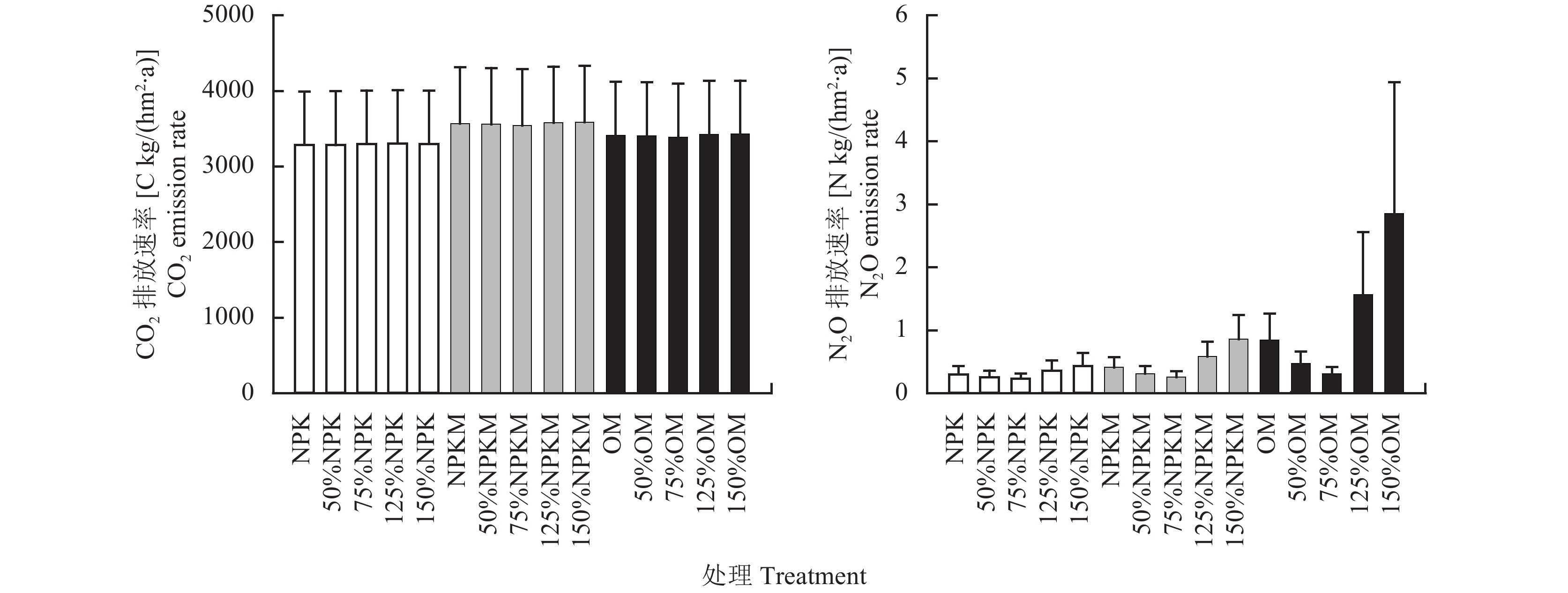 |
| 图6 长期不同施肥情景下土壤CO2和土壤N2O的年均排放量 Fig. 6 Average annual soil CO2 and N2O emissions under different long-term fertilization scenarios |
统计结果显示 (表4),SPACSYS模型可以很好地模拟小麦和玉米产量的年际动态变化,只有个别年份的模拟值与实测值有些偏差,如模型高估了OM处理2011年的玉米产量约42%,这可能是由于模型在输入数据方面存在误差,如模型使用的气象数据来源于中国气象局 (http://data.cma.cn/site/index.html) 开封实验站,这可能与封丘当地的小气候之间存在差异。本研究显示SPACSYS模型低估了OM处理的全氮储量,由于缺少试验数据支撑,本文未对土层硝态氮的淋失进行验证,因此,高估氮素淋失量可能是造成全氮储量模拟值偏低的原因之一。有研究表明,华北平原农田施氮量为N 340 kg/(hm2·a) 时,土层氮素淋失量为N 17.3 kg/(hm2·a)[44]。李晓欣等[45]对华北地区太行山山前平原冬小麦−夏玉米氮素淋失研究得出,当施氮量为N 200、400和800 kg/(hm2·a) 时,通过180 cm土层的硝态氮淋失量分别为2、38和160 kg/hm2。由此可见,本研究可能高估了土壤硝态氮的淋失量进而导致对全氮储量的模拟偏低。
| 表4 模拟作物产量、土壤碳氮储量及土壤CO2、N2O排放效果的统计分析 Table 4 Statistical analysis of the simulated crop yields, SOC and TN storages, CO2 and N2O emissions |
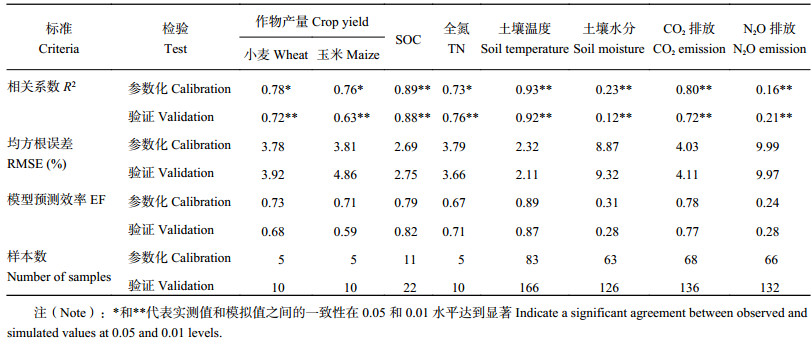 |
SPACSYS模型将土壤−植物−大气系统的水分分为冠层水、地表水和剖面水三个部分。模型利用Penman-Monteith方程[46]对植物潜在蒸散量进行估算。有研究表明辐射在Penman-Monteith方程中起到重要作用,辐射的准确度直接影响到方程的计算精度[47]。因此,本研究所使用的气象数据的误差可能是产生土壤水分模拟误差的原因之一。另外,方程在估算植物蒸发量时将气孔阻力设置为一个定值,而实际上植物叶片的气孔阻力是随叶龄及生育期的变化而变化的[48],因此,气孔阻力的设置也可能导致土壤水分的模拟效果不好。而本研究所使用的土壤水分实测数据为土壤表层 (0—5 cm) 水分含量,易受外界环境因素 (如降雨、风速等) 的影响,往往实测值的准确性也较低。土壤水分含量模拟的准确度会影响到土壤N2O排放量模拟的准确度,土壤含水量主要通过影响土壤通气状况和土壤微生物的活性进而影响土壤N2O的排放[49]。
3.3 模型模拟不同施肥情景下的作物产量不同施肥情景下作物产量的模拟结果显示 (表5),减氮25%~50%基本能够维持现有作物产量,因此封丘地区可以适当降低氮肥施用量来减少资源浪费及环境污染。有研究表明华北平原部分地区农田减氮施肥不会降低小麦玉米产量[50]。朱兆良[51]研究表明,每季作物施氮量控制在120~180 kg/hm2时,小麦和玉米都能达到较高的产量。刘学军等[52]进一步研究表明在年施氮量减至60 kg/hm2时,小麦产量会显著降低。
3.4 模型模拟不同施肥情景下的土壤碳氮储量、土壤碳氮收支及土壤温室气体排放增氮情景下土壤碳、氮储量及土壤温室气体排放的模拟结果显示 (表5),单施化肥处理及有机肥配施化肥处理增氮25%均不能显著提高SOC年均储量,单施有机肥处理增氮25%或50%均可显著提高SOC年均储量,但也提高了土壤N2O排放量。当前施肥情景及减氮施肥情景下土壤碳氮储量及土壤温室气体排放的模拟结果显示 (表5),OM处理的SOC年均储量最大,达到C 28.26 t/hm2,即OM处理对于土壤固碳的效应是最大的。然而OM处理的N2O年均排放量也是最高的,达到了N 0.84 kg/(hm2·a),约为NPKM和NPK处理的2~3倍。NPKM处理的SOC年均储量显著高于NPK处理,而其N2O年均排放量显著低于OM处理。笔者的研究结果也验证了前人研究,农田土壤施用有机肥可以提高SOC固定,同时也增加了土壤N2O的排放量[53–55]。其原因可能是:1)有机肥的施用为异养微生物的活动提供了大量的能量来源,因此增加了反硝化过程中的N2O产生量[56–57];2)有机肥的施用刺激了硝化过程中的N2O产生量[58–59]。也有研究表明施用有机肥能够减少土壤N2O排放[60]。
不同施肥情景下土壤碳氮收支的模拟结果表明 (表6和表7),不同施肥措施下封丘农田土壤−作物系统均作为大气CO2不同程度的“汇”,“碳汇”强度表现为单施有机肥 > 有机肥配施化肥 > 单施化肥。相比单施化肥处理,有机肥配施化肥处理和单施有机肥处理能增加土壤“碳汇”,这与前人研究结果较为一致。潘根兴等 [61]认为长期有机无机肥料配合施用可以显著增加土壤表层有机碳含量;金琳等[62]研究表明,有机无机肥料配合施用对“碳汇”效应较为明显;李洁静等[63]研究表明,有机无机肥料配施处理的SOC含量是单施化肥处理的3倍。减氮施肥可以降低氮素损失,当前施肥情景下单施化肥处理、有机肥配施化肥处理和单施有机肥处理通过淋溶、径流及反硝化途径的氮素总损失量分别达到施氮量的11%、18%和21%,这与Zhang等[30]的研究结果类似,而与岳现录等[64]的研究结果有所不同,他们指出有机肥的氮损失低于化肥氮损失约30%,这可能是由于所使用的有机肥不同所造成的[65–66]。
针对华北平原农田,已有大量研究表明施用有机肥是保障粮食产量、提高土壤肥力及兼顾环境效益的最佳选择[67–68]。农田氮肥施用量过高,导致了一系列的环境问题,减氮施肥成为当前华北平原农田施肥的重要措施[69–71]。已有研究表明减氮施肥对于维持作物产量及减缓温室效应具有重要作用。Han等[72]研究得出华北平原农田土壤当前施氮量下 (250 kg/hm2) 减氮20%不会降低作物产量,相反分别降低了冬小麦−夏玉米轮作周期土壤CO2和N2O排放量6.4%和16.2%。李新华等[73]对黄淮海地区小麦季减氮施肥条件下温室气体排放的研究得出,与农民传统施氮量 (N 300 kg/hm2) 相比,减氮10%、20%和30%,小麦产量无显著变化,农田土壤CO2排放量分别降低了4.9%、18.7%和36.5%,N2O排放量分别降低了21.9%、32.5%和40.4%。综上,封丘地区可在当前施氮量的基础上适当降低氮肥施用量 (减氮25%) 并采用有机肥配施化肥或单施有机肥的方式来维持作物产量、提升土壤肥力及降低温室气体排放,起到固碳减排的作用,即可将75%NPKM或75%OM处理作为当前封丘农田的优化施肥处理。
4 结论SPACSYS模型可以模拟中国华北平原典型农田冬小麦−夏玉米轮作体系的农作物产量、SOC和TN储量以及土壤CO2和N2O的排放情况。但是模型低估了OM处理的TN储量。因此,下一步研究需对模型进行相应的改进。施肥管理情景模拟结果表明,至2050年,各处理SOC和全氮储量都有不同程度的提升。另外,可适当降低该地区氮肥施用量 (减氮25%) 并采用有机肥配施化肥或单施有机肥的方式来维持作物产量、提升土壤肥力,同时降低温室气体排放。
| [1] |
裴淑玮, 张圆圆, 刘俊锋, 等. 施肥及秸秆还田处理下玉米季温室气体的排放[J].
环境化学, 2012, 31(4): 407–414.
Pei S W, Zhang Y Y, Liu J F, et al. Greenhouse gas emission under the treatments of fertilization and wheat straw returning during the maize growing seasons[J]. Environmental Chemistry, 2012, 31(4): 407–414. |
| [2] |
国家发展和改革委员会应对气候变化司. 中华人民共和国气候变化第二次国家信息通报[M]. 北京: 中国经济出版社, 2013.
Department of Climate Change, National Development and Reform Commission. Second national information circular on climate change of the People’s Republic of China[M]. Beijing: China Economic Press, 2013. |
| [3] | Cui Z L, Chen X P, Zhang F S. Current nitrogen management status and measures to improve the intensive wheat-maize system in China[J]. Ambio, 2010, 39(5-6): 376–384. DOI:10.1007/s13280-010-0076-6 |
| [4] | Zhu Z L, Chen D L. Nitrogen fertilizer use in China−Contributions to food production, impacts on the environment and best management strategies[J]. Nutrient Cycling in Agroecosystems, 2002, 63(2-3): 117–127. |
| [5] | Ju X T, Xing G X, Chen X P, et al. Reducing environmental risk by improving N management in intensive Chinese agricultural systems[J]. Proceedings of the National Academy of Sciences, 2009, 106(9): 3041–3046. DOI:10.1073/pnas.0813417106 |
| [6] | Guo J H, Liu X J, Zhang Y, et al. Significant acidification in major Chinese croplands[J]. Science, 2010, 327(5968): 1008–1010. DOI:10.1126/science.1182570 |
| [7] |
王少杰. 氮肥与秸秆还田对陕西关中灌区农田CO2、CH4排放的影响[D]. 陕西杨凌: 西北农林科技大学硕士学位论文, 2012.
Wang S J. Effect of nitrogen fertilizer and straw returning on CO2 and CH4 emissions from farmland in Guanzhong irrigation area of Shaanxi province[D]. Yangling, Shaanxi: MS Thesis of Northwest A&F University, 2012. |
| [8] |
王玉英, 李晓欣, 董文旭, 等. 华北平原农田温室气体排放与减排综述[J].
中国生态农业学报, 2018, 26(2): 167–174.
Wang Y Y, Li X X, Dong W X, et al. Review on greenhouse gas emission and reduction in wheat-maize double cropping system in the North China Plain[J]. Chinese Journal of Eco-Agriculture, 2018, 26(2): 167–174. |
| [9] |
黄国宏, 陈冠雄, 韩冰, Oswald Van Cleemput. 土壤含水量与N2O产生途径研究
[J].
应用生态学报, 1999, 10(1): 53–56.
Huang G H, Chen G X, Han B, Van Cleemput O. Relationships between soil water content and N2O production [J]. Chinese Journal of Applied Ecology, 1999, 10(1): 53–56. DOI:10.3321/j.issn:1001-9332.1999.01.014 |
| [10] | Liu C Y, Wang K J, Zheng X. Responses of N2O and CH4 fluxes to fertilizer nitrogen addition rates in an irrigated wheat-maize cropping system in northern China [J]. Biogeosciences, 2012, 9(2): 839–850. DOI:10.5194/bg-9-839-2012 |
| [11] | Steiner C, Teixeira W G, Lehmann J, et al. Long-term effects of manure, charcoal and mineral fertilization on crop production and fertility on a highly weathered Central Amazonian upland soil[J]. Plant and Soil, 2007, 291(2): 275–290. |
| [12] |
宇万太, 姜子绍, 马强, 周桦. 施用有机肥对土壤肥力的影响[J].
植物营养与肥料学报, 2009, 15(5): 1057–1064.
Yu W T, Jiang Z S, Ma Q, Zhou H. Effect of applying manure on soil fertility[J]. Plant Nutrition and Fertilizer Science, 2009, 15(5): 1057–1064. DOI:10.3321/j.issn:1008-505X.2009.05.011 |
| [13] | Maillard É, Angers D A. Animal manure application and soil organic carbon stocks: a meta-analysis[J]. Global Change Biology, 2014, 20(2): 666–679. DOI:10.1111/gcb.2014.20.issue-2 |
| [14] | Smith K A, Jackson D R, Pepper T J. Nutrient losses by surface run-off following the application of organic manures to arable land. 1. Nitrogen[J]. Environmental Pollution, 2001, 112(1): 41–51. DOI:10.1016/S0269-7491(00)00097-X |
| [15] | Bouwman A F, Boumans L J M, Batjes N H. Modeling global annual N2O and NO emissions from fertilized fields [J]. Global Biogeochemical Cycles, 2002, 16(4): 28(1): 28–29. |
| [16] | Zhou M H, Zhu B, Brüggemann N, et al. Sustaining crop productivity while reducing environmental nitrogen losses in the subtropical wheat-maize cropping systems: A comprehensive case study of nitrogen cycling and balance[J]. Agriculture Ecosystems and Environment, 2016, 231: 1–14. DOI:10.1016/j.agee.2016.06.022 |
| [17] | Smith P, Martino D, Cai Z C, et al. Greenhouse gas mitigation in agriculture[J]. Philosophical Transactions Biological Sciences, 2008, 363(1492): 789–813. DOI:10.1098/rstb.2007.2184 |
| [18] | Chen X P, Cui Z L, Fan M S, et al. Producing more grain with lower environmental costs[J]. Nature, 2014, 514(7523): 486–502. DOI:10.1038/nature13609 |
| [19] | Jeuffroy M H, Casadebaig P, Debaeke P, et al. Agronomic model uses to predict cultivar performance in various environments and cropping systems. A review[J]. Agronomy for Sustainable Development, 2014, 34(1): 121–137. DOI:10.1007/s13593-013-0170-9 |
| [20] | Uzoma K C, Smith W, Grant B, et al. Assessing the effects of agricultural management on nitrous oxide emissions using flux measurements and the DNDC model[J]. Agriculture Ecosystems & Environment, 2015, 206: 71–83. |
| [21] | Li H, Qiu J J, Wang L G, et al. Modeling impacts of alternative farming management practices on greenhouse gas emissions from a winter wheat-maize rotation system in China[J]. Agriculture Ecosystems & Environment, 2010, 135(1/2): 24–33. |
| [22] | Wang Z Z, Qi Z M, Xue L L, et al. Modeling the impacts of climate change on nitrogen losses and crop yield in a subsurface drained field[J]. Climatic Change, 2015, 129(1/2): 323–335. |
| [23] | Ri X, Prentice I C, Spahni R, Niu H S. Modeling terrestrial nitrous oxide emissions and implications for climate feedback[J]. New Phytologist, 2012, 196(2): 472–488. DOI:10.1111/j.1469-8137.2012.04269.x |
| [24] | Wang E, Oosterom E V, Meinke H, et al. The new APSIM-Wheat Model: Performance and future improvements[A].Australian Society of Agronomy. 11th Australian society of agronomy conference[C]. Geelong, Australia: Australian Society of Agronomy,2003. |
| [25] | Liang H, Hu K L, Batchelor W D, et al. An integrated soil-crop system model for water and nitrogen management in North China[J]. Scientific Reports, 2016, 6: 25755–25774. DOI:10.1038/srep25755 |
| [26] | Li C S, Salas W, Zhang R H, et al. Manure-DNDC: a biogeochemical process model for quantifying greenhouse gas and ammonia emissions from livestock manure systems[J]. Nutrient Cycling in Agroecosystems, 2012, 93(2): 163–200. DOI:10.1007/s10705-012-9507-z |
| [27] | Smith W N, Grant B B, Desjardins R L, et al. Assessing the effects of climate change on crop production and GHG emissions in Canada[J]. Agriculture Ecosystems and Environment, 2013, 179(5): 139–150. |
| [28] | Chirinda N, Kracher D, Lægdsmand M, et al. Simulating soil N2O emissions and heterotrophic CO2 respiration in arable systems using FASSET and MoBiLE-DNDC [J]. Plant and Soil, 2011, 343(1/2): 139–160. |
| [29] | Wu L H, McGechan M B, McRoberts N, et al. SPACSYS: integration of a 3D root architecture component to carbon, nitrogen and water cycling-Model description[J]. Ecological Modeling, 2007, 200(3/4): 343–359. |
| [30] | Zhang X B, Xu M G, Sun N, et al. Modeling and predicting crop yield, soil carbon and nitrogen stocks under climate change scenarios with fertilizer management in the North China Plain[J]. Geoderma, 2016, 265: 176–186. DOI:10.1016/j.geoderma.2015.11.027 |
| [31] | Bingham I J, Wu L H. Simulation of wheat growth using the 3D root architecture model SPACSYS: Validation and sensitivity analysis[J]. European Journal of Agronomy, 2011, 34(3): 181–189. DOI:10.1016/j.eja.2011.01.003 |
| [32] | Wu L H, McGechan M B. Simulation of nitrogen uptake, fixation and leaching in a grass/white clover mixture[J]. Grass and Forage Science, 1999, 54(1): 30–41. DOI:10.1046/j.1365-2494.1999.00145.x |
| [33] | Wu L H, Whitmore A P, Bellocchi G. Modeling the impact of environmental changes on grassland systems with SPACSYS[J]. Advances in Animal Biosciences, 2015, 6(1): 37–39. |
| [34] | Meng L, Ding W X. Long-term application of organic manure and nitrogen fertilizer on N2O emissions, soil quality and crop production in a sandy loam soil[J]. Soil Biology and Biochemistry, 2005, 37(11): 2037–2045. DOI:10.1016/j.soilbio.2005.03.007 |
| [35] | Wu L H, Rees R M, Tarsitano D, et al. Simulation of nitrous oxide emissions at field scale using the SPACSYS model[J]. Science of the Total Environment, 2015, 530-531: 76–86. DOI:10.1016/j.scitotenv.2015.05.064 |
| [36] | Zhang X B, Sun Z G, Liu J, et al. Simulating greenhouse gas emissions and stocks of carbon and nitrogen in soil from a long-term no-till system in the North China Plain[J]. Soil & Tillage Research, 2018, 178(281): 32–40. |
| [37] | Wu L H, Shepherd A. Special features of the SPACSYS modeling package and procedures for parameterization and validation[J]. Aspects of Applied Biology, 2011, 107: 57–62. |
| [38] | Liang S, Li Y F, Zhang X B, et al. Response of crop yield and nitrogen use efficiency for wheat-maize cropping system to future climate change in northern China[J]. Agricultural and Forest Meteorology, 2018, 262: 310–321. DOI:10.1016/j.agrformet.2018.07.019 |
| [39] |
徐明岗, 张文菊, 黄绍敏, 等. 中国土壤肥力演变(第二版)[M]. 北京: 中国农业科学技术出版社, 2015. 408–415.
Xu M G, Zhang W J, Huang S M, et al. Evolution of soil fertility in China (2nd Ed.)[M]. Beijing: China Agricultural Science and Technology Press, 2015. 408–415. |
| [40] | Yan X Y, Gong W. The role of chemical and organic fertilizers on yield, yield variability and carbon sequestration— results of a 19-year experiment[J]. Plant & Soil, 2010, 331(1/2): 471–480. |
| [41] | Cai Y J, Ding W X, Luo J F. Nitrous oxide emissions from Chinese maize–wheat rotation systems: A 3-year field measurement[J]. Atmospheric Environment, 2013, 65(65): 112–122. |
| [42] | Ding W X, Luo J F, Li J, et al. Effect of long-term compost and inorganic fertilizer application on background N2O and fertilizer-induced N2O emissions from an intensively cultivated soil[J]. Science of the Total Environment, 2013, 465: 115–124. DOI:10.1016/j.scitotenv.2012.11.020 |
| [43] | Ding W X, Meng L, Yin Y F, et al. CO2 emission in an intensively cultivated loam as affected by long-term application of organic manure and nitrogen fertilizer [J]. Soil Biology and Biochemistry, 2007, 39(2): 669–679. DOI:10.1016/j.soilbio.2006.09.024 |
| [44] |
李虎, 王立刚, 邱建军. 基于DNDC模型的华北典型农田氮素损失分析及综合调控途径[J].
中国生态农业学报, 2012, 20(4): 414–421.
Li H, Wang L G, Qiu J J. Nitrate loss simulated with DNDC model and control technologies in typical cropland of North China[J]. Chinese Journal of Eco-Agriculture, 2012, 20(4): 414–421. |
| [45] |
李晓欣, 胡春胜, 张玉铭, 等. 华北地区小麦-玉米种植制度下硝态氮淋失量研究[J].
干旱地区农业研究, 2006, 24(6): 7–10.
Li X X, Hu C S, Zhang Y M, et al. Losses of nitrate-nitrogen from a wheat-corn rotation in north China[J]. Agricultural Research in the Arid Areas, 2006, 24(6): 7–10. DOI:10.3321/j.issn:1000-7601.2006.06.002 |
| [46] | Monteith J L. Evaporation and environment[A]. Proceedings of the 19th Symposia of the Society for Experimental Biology: The State and Movement of Water in Living Organisms[C]. London: Cambridge University Press, 1965. 205-234. |
| [47] |
刘国水. 作物蒸散量测定与计算方法研究[D]. 保定: 河北农业大学硕士学位论文, 2008.
Liu G S. The study on the crop evapotranspiration measurement and computation[D]. Baoding: MS Thesis of Hebei Agricultural University, 2008. |
| [48] |
刘浩, 段爱旺, 孙景生, 等. 基于Penman-Monteith方程的日光温室番茄蒸腾量估算模型[J]. 农业工程学报, 2011, 27(9): 208–213.
Liu H, Duan A W, Sun J S, Liu Z G. Estimating model of transpiration for greenhouse tomato based on Penman-Monteith equation[J]. Transactions of the CSAE, 2011, 27(9): 208–213. |
| [49] |
营娜. 中国农田N2O直接排放、空间分布以及变化趋势[D]. 芜湖: 安徽师范大学硕士论文, 2014.
Ying N. Agricultural N2O direct emissions, spatial distribution and trends in China[D]. Wuhu: MS Thesis of Anhui Normal University, 2014. |
| [50] |
云鹏, 高翔, 陈磊, 等. 冬小麦-夏玉米轮作体系中不同施氮水平对玉米生长及其根际土壤氮的影响[J]. 植物营养与肥料学报, 2010, 16(3): 567–574.
Yun P, Gao X, Chen L, et al. Effects of different nitrogen levels on maize growth and rhizosphere soil N in winter wheat-summer maize rotation system[J]. Journal of Plant Nutrition and Fertilizer, 2010, 16(3): 567–574. |
| [51] |
朱兆良. 农田中氮肥的损失与对策[J].
生态环境学报, 2000, 9(1): 1–6.
Zhu Z L. Loss of fertilizer N from plants-soil system and the strategies and techniques for its reduction[J]. Soil and Environmental Sciences, 2000, 9(1): 1–6. DOI:10.3969/j.issn.1674-5906.2000.01.001 |
| [52] |
刘学军, 巨晓棠, 张福锁. 减量施氮对冬小麦-夏玉米种植体系中氮利用与平衡的影响[J].
应用生态学报, 2004, 15(3): 458–462.
Liu X J, Ju X T, Zhang F S. Effects of reduced nitrogen application on nitrogen use and balance in winter wheat-summer maize planting system[J]. Chinese Journal of Applied Ecology, 2004, 15(3): 458–462. DOI:10.3321/j.issn:1001-9332.2004.03.020 |
| [53] | Gu J X, Yuan M X, Liu J X, et al. Trade-off between soil organic carbon sequestration and nitrous oxide emissions from winter wheat-summer maize rotations: Implications of a 25-year fertilization experiment in Northwestern China[J]. Science of the Total Environment, 2017, 595: 371–379. DOI:10.1016/j.scitotenv.2017.03.280 |
| [54] | Zhou M H, Zhu B, Wang S J, et al. Stimulation of N2O emission by manure application to agricultural soils may largely offset carbon benefits: a global meta-analysis[J]. Global Change Biology, 2017, 23(10): 4068–4083. DOI:10.1111/gcb.2017.23.issue-10 |
| [55] | Li C S, Frolking S, Butterbach-Bahl K. Carbon sequestration in arable soils is likely to increase nitrous oxide emissions, offsetting reductions in climate radiative forcing[J]. Climatic Change, 2005, 72(3): 321–338. DOI:10.1007/s10584-005-6791-5 |
| [56] | Ju X T, Lu X, Gao Z L, et al. Processes and factors controlling N2O production in an intensively managed low carbon calcareous soil under sub-humid monsoon conditions[J]. Environmental Pollution, 2011, 159(3): 1007–1016. |
| [57] | Chen Z M, Ding W X, Luo Y Q, et al. Nitrous oxide emissions from cultivated black soil: A case study in Northeast China and global estimates using empirical model[J]. Global Biogeochemical Cycles, 2015, 28(11): 1311–1326. |
| [58] | Meijide A, Diez J A, SáNchezmartí N L, et al. Nitrogen oxide emissions from an irrigated maize crop amended with treated pig slurries and composts in a Mediterranean climate[J]. Agriculture Ecosystems and Environment, 2007, 121(4): 383–394. |
| [59] | Ding W X, Luo J F, Li J, et al. Effect of long-term compost and inorganic fertilizer application on background N2O and fertilizer-induced N2O emissions from an intensively cultivated soil[J]. Science of the Total Environment, 2013, 465(6): 115–124. |
| [60] |
翟振, 王立刚, 李虎, 等. 有机无机肥料配施对春玉米农田N2O排放及净温室效应的影响
[J].
农业环境科学学报, 2013, 32(12): 2495–2501.
Zhai Z, Wang L G, Li H, et al. Nitrous oxide emissions and net greenhouse effect from spring-maize field as influenced by combined application of manure and inorganic fertilizer[J]. Journal of Agro-Environment Science, 2013, 32(12): 2495–2501. DOI:10.11654/jaes.2013.12.024 |
| [61] |
潘根兴, 周萍, 张旭辉, 等. 不同施肥对水稻土作物碳同化与土壤碳固定的影响—以太湖地区黄泥土肥料长期试验为例[J].
生态学报, 2006, 26(11): 3704–3710.
Pan G X, Zhou P, Zhang X H, et al. Effect of different fertilization practices on crop carbon assimilation and soil carbon sequestration: A case of a paddy under a long-term fertilization trial from the Tai Lake region, China[J]. Acta Ecologica Sinica, 2006, 26(11): 3704–3710. DOI:10.3321/j.issn:1000-0933.2006.11.024 |
| [62] |
金琳, 李玉娥, 高清竹, 等. 中国农田管理土壤碳汇估算[J].
中国农业科学, 2008, 41(3): 734–743.
Jin L, Li Y E, Gao Q Z, et al. Estimate of carbon sequestration under cropland management in China[J]. Scientia Agricultura Sinica, 2008, 41(3): 734–743. DOI:10.3864/j.issn.0578-1752.2008.03.014 |
| [63] |
李洁静, 潘根兴, 李恋卿, 张旭辉. 红壤丘陵双季稻稻田农田生态系统不同施肥下碳汇效应及收益评估[J].
农业环境科学学报, 2009, 28(12): 2520–2525.
Li J J, Pan G X, Li L Q, Zhang X H. Estimation of net carbon balance and benefits of rice-rice cropping farm of a red earth paddy under long term fertilization experiment from Jiangxi, China[J]. Journal of Agro-Environment Science, 2009, 28(12): 2520–2525. DOI:10.3321/j.issn:1672-2043.2009.12.013 |
| [64] |
岳现录, 冀宏杰, 张认连, 等. 华北平原冬小麦-夏玉米轮作体系秋季一次基施牛粪氮素损失与利用研究[J].
植物营养与肥料学报, 2011, 17(3): 592–599.
Yue X L, Ji H J, Zhang R L, et al. Nitrogen loss and use efficiency of one-time basal application of cattle manure in autumn to a winter wheat-summer maize cropping system on the North China Plain[J]. Plant Nutrition and Fertilizer Science, 2011, 17(3): 592–599. |
| [65] |
邹建文, 黄耀, 宗良纲, 等. 不同种类有机肥施用对稻田CH4和N2O排放的综合影响
[J].
环境科学, 2003, 24(4): 7–12.
Zou J W, Huang Y, Zong L G, et al. Integrated effect of incorporation with different organic manures on CH4 and N2O emissions from rice paddy [J]. Environmental Science, 2003, 24(4): 7–12. DOI:10.3969/j.issn.1674-2842.2003.04.003 |
| [66] |
董玉红, 欧阳竹, 李运生, 等. 肥料施用及环境因子对农田土壤CO2和N2O排放的影响
[J].
农业环境科学学报, 2005, 24(5): 913–918.
Dong Y H, Ouyang Z, Li Y S, et al. Influence of fertilization and environmental factors on CO2 and N2O fluxes from agricultural soil [J]. Journal of Agro-Environment Science, 2005, 24(5): 913–918. DOI:10.3321/j.issn:1672-2043.2005.05.017 |
| [67] |
雷强. 有机肥化肥配施对华北高产农田土壤温室气体排放的影响[D]. 山西太谷: 山西农业大学硕士学位论文, 2015.
Lei Q. Effects of partial mineral nitrogen substitution by organic fertilizer nitrogen on emissions of greenhouse gases in the North China Plain[D]. Taigu, Shanxi: MS Thesis of Shanxi Agricultural University, 2015. |
| [68] | Liu H T, Li J, Li X, et al. Mitigating greenhouse gas emissions through replacement of chemical fertilizer with organic manure in a temperate farmland[J]. Science Bulletin, 2015, 60(6): 598–606. DOI:10.1007/s11434-014-0679-6 |
| [69] |
王秀斌, 梁国庆, 周卫, 等. 优化施肥下华北冬小麦/夏玉米轮作体系农田反硝化损失与N2O排放特征
[J].
植物营养与肥料学报, 2009, 15(1): 48–54.
Wang X B, Liang G Q, Zhou W, et al. Effect of optimized nitrogen application on denitrification losses and N2O emissions from soil in winter wheat-summer corn rotation system in North China [J]. Plant Nutrition and Fertilizer Science, 2009, 15(1): 48–54. DOI:10.3321/j.issn:1008-505X.2009.01.007 |
| [70] |
盛康, 潘广元, 李友强, 等. 不同施肥模式对小麦产量和品质的影响[J].
安徽农业大学学报, 2014, 41(4): 540–544.
Sheng K, Pan G Y, Li Y Q, et al. Effect of different fertilizer treatments on yield and quality of wheat[J]. Journal of Anhui Agricultural University, 2014, 41(4): 540–544. |
| [71] |
杨莉琳, 贾良良, 胡春胜, 等. 太行山山前平原冬小麦-夏玉米推荐施肥指标的修正[J].
农业工程学报, 2007, 23(11): 89–94.
Yang L L, Jia L L, Hu C S, et al. Revision of fertilizer recommendation for wheat and maize rotation in Taihang piedmont of North China[J]. Transactions of the Chinese Society of Agricultural Engineering, 2007, 23(11): 89–94. DOI:10.3321/j.issn:1002-6819.2007.11.015 |
| [72] | Han X, Fan J W, Bai J H, et al. Effects of reduced nitrogen fertilization and biochar application on CO2 and N2O emissions from a summer maize-winter wheat rotation field in North China [J]. Agricultural Science and Technology, 2016, 17(12): 2800–2808. |
| [73] |
李新华, 朱振林, 董红云, 等. 氮肥减施对黄淮海地区麦田温室气体排放的影响[J].
土壤与作物, 2016, 5(4): 215–222.
Li X H, Zhu Z L, Dong H Y, et al. Effects of reduced N fertilizer application on greenhouse gas emissions from wheat fields in Huang-huai-hai area[J]. Soils and Crops, 2016, 5(4): 215–222. |
 2018, Vol. 24
2018, Vol. 24  doi:
doi: 

